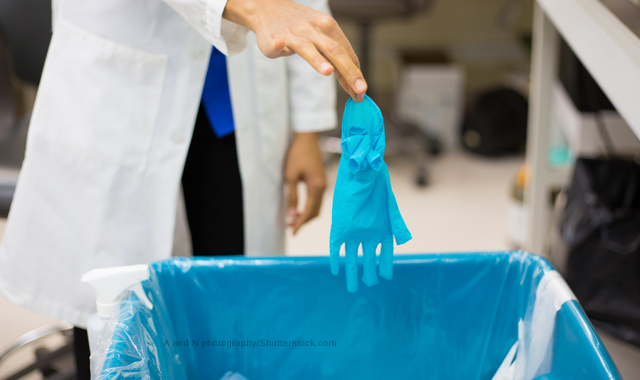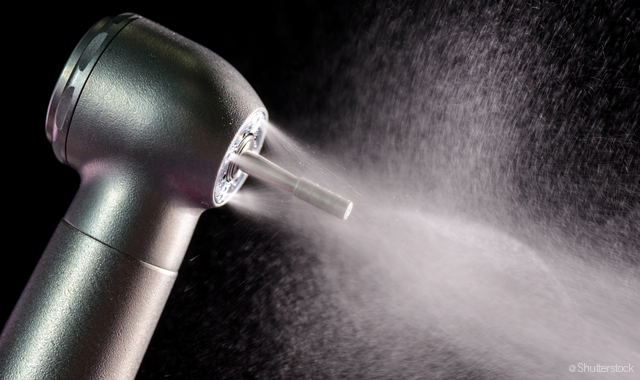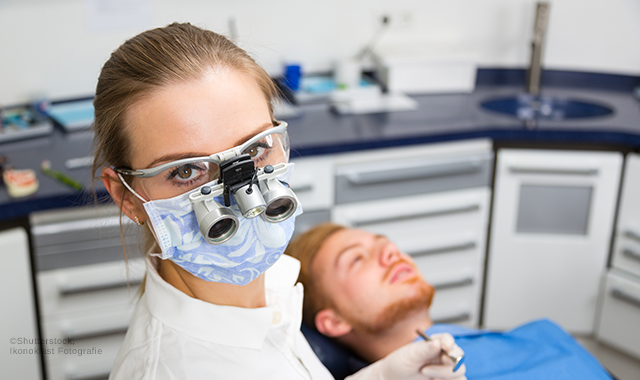5 things you should be doing NOW to improve infection control
Paying attention to these details can mean preventing infection risks for both your patients and staff.
Running a dental practice is a lot of work. In addition to worrying about buying supplies, billing, HR and countless other items, there’s also the tiny issue of actually performing dentistry. With so many things going on, it’s easy to forget something or want to cut corners. However, proper infection control is not one of the places to be lax.
With that in mind, here are five things that you should do right now to improve infection control.
Click through the slides to read more.


Use the right surface disinfectant
It isn’t enough just to spray a surface disinfectant on and then wipe it off. It is important to make sure it stays wet on the surface for the prescribed about of time.
“Be sure the staff is familiar with the instruction labels on that product,” says Doug Braendle, product manager at SciCan. “There are a lot of products out there that have a 10-minute wet contact time. That means on the label it says in order for this product to disinfect it, you have to spray it on or wipe it on and leave it on the surface, wet, for 10 minutes in order for it to work. Well, in today's age, to be honest with you, nobody has 10 minutes between patients. If they don't put down enough chemistry to keep that surface wet for 10 minutes, then they're not disinfecting. But if you're not familiar with the label and what the actual instructions are for the product that you're using, then there's a reasonable chance that you're just not getting it disinfected.”
Related reading: 5 common mistakes that can ruin your infection control efforts
Different products have different wet times. Depending on the chemicals used, some require less time than others and some require more. While the motivation might be to purchase a product that has very short wet time, those products tend to be more caustic and corrosive.
“Sometimes when you get down to that one minute time, you have to also worry about if it is corrosive to some of the things that you’re coming in contact with,” Braendle says. “In order to come down in time, these companies have to use a pretty nasty chemical. Try to look for a blend of safety, efficiency and time savings.”



Further your education
Knowledge, as they say, is power, and the more the team knows about infection control the better.
“Regardless of whether infection prevention continuing education is mandatory in your state, when it comes to patient and employee safety, it’s one of those things where you don't know what you don't know,” says Karen Daw, an infection control consultant and former clinic health and safety director for The Ohio State University College of Dentistry. “Have the entire team get together and listen to a speaker or a consultant. Everybody hears the same message, and everybody receives the same updates, too.”
Trending article: The latest hourly and annual salary numbers for dentists and dental assistants
Daw says she's seen practices get infrequent updates (less than once a year), utilize underqualified staff and even rely on outdated materials (one office even used old VHS video tapes for their OSHA and Infection Control training).
“The simplest, and in my opinion, the most effective thing they can do is attend training, at least annually,” Daw says. “Listen to some different expert speakers. No one can cover all of the requirements, standards and guidelines in a two-hour CE course, but if you attend enough of them, you'll get a good 30,000-foot view of what you should be doing in your office.”
Some places to get that training include:
- Local dental societies
- Dental conferences
- State dental associations
- Nearby dental schools
- Dental consultants
“I'm not saying online training won't fulfill it, however, the onus falls on the practice to ensure it meets federal and state requirements and provides necessary updates. For example, OSHA specifically has a list or requirements for the Bloodborne Pathogens trainer. The modality of the training should be one that helps the participant retain the information in the long run. Engage the team with different speakers, locations and content. Let’s mix it up,” she says.



Use the right gloves
Gloves might just seem like gloves, but certain jobs require specific types of hand protection.
“Some offices are just using latex or whatever gloves they are using chairside for cleanup,” Braendle says. “Not only in the sterilization center, but also in the operatories when they're cleaning up after patients. What you should be using are utility gloves. They're kind of purple in color. They would be the equivalent of a Playtex-like glove-like what you might see grandma wearing when she's doing dishes. The whole idea of the utility glove is, there are brands and materials of service disinfectants that we don't want coming in contact with skin, and at that point anybody's glove would be fine, but the reason the CDC mandates the utility glove is because I'm not worried about chemistry, I'm worried about pricks and pokes."
Like so many things, carelessness can lead to problems, but the right gloves can help avoid catastrophe.
Read more: 10 questions you need to ask about infection control
“Someone may go through this routine 50 times a day, and sometimes you tend to get a little blasé, where you're not paying attention,” Braendle says. “So you're wiping down counters, you're moving quickly because you’ve got another patient waiting to come in and there may be dirty instruments left on the end of the counter, so these utility gloves are basically for protection. The really thin gloves that they're wearing don’t really protect them.”
It’s often a matter of personal protection, but it might also just be the law in your state.
“If the state that you're working in has adopted CDC guidelines, then that's your state law,” Braendle says. “You can actually get in trouble for not doing what you should be doing. CDC just makes recommendations, but when the state adopts it, then the state dental board puts teeth in it, because then it’s state law.”



Join a professional organization
Professional organizations are excellent resources to keep your practice on top of important issues, and Daw recommends joining the Organization for Safety, Asepsis and Prevention (OSAP).
Trending article: The dangers of STDs in the dental practice
“OSAP’s mission is to ensure the safest dental visit,” Daw says. “Members receive newsletters, education, and the latest updates on infection prevention and safety as it pertains, specifically, to the field of dentistry.”
“If you haven't looked into OSAP yet, you should,” she continues. “I've experienced numerous benefits with my membership. They are the go-to resource for all things dental safety-related.”



Sterilize slow-speed handpiece motors
Another reason to keep up on continuing education are changes in government mandates. For instance, in 2016, the CDC issued a new rule requiring the sterilization of slow-speed handpieces.
“That was not in the rules before,” Braendle observes. “So we make sure that we’re sterilizing the slow speed motors that we’re using for prophys, that we’re using for hygiene and also using in the operatories.”
The rule was changed because it was discovered that the slow-speed motors were at risk of causing infections.
“There were some tests done by the CDC, and they were saying that the grit from the prophy paste was kind of migrating down through the prophy angle and then getting into the gears and getting into the motor itself,” Braendle explains. “So if we had that kind of migration, and it was prophy paste that was splattered with blood or saliva, then that motor becomes contaminated.”
More from the author: How COMPONEER provides a cosmetic element to the everyday dentist’s practice
Unfortunately, depending on the type of slow-speed handpieces you own, they might have to be replaced.
“Some slow-speed motors are just not appropriate,” Braendle says. “Older school motors can't be autoclaved, and those don't really have a place in today's dental office because they do have to be autoclaved.”
With so many details involved in running a dental practice, it’s easy to take a shortcut or simply not be aware of important changes. However, paying attention to those details can mean preventing infection risks for both your patients and staff.

